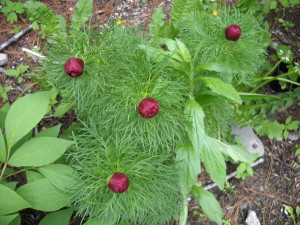Freeing Up Prime Real Estate in the Garden
As a gardener I find that inertia is my enemy. I plant things, and then just let them remain (whether I like them or not) – even if they take up a lot of space. I removed two such plants this summer. First, I cut down a pie cherry that produced blah-tasting fruit and not much of it. Next, I had a huge patch of lovage, a celery relative that over the past 20 years had spread to take up an 8-foot piece of prime real estate just outside my kitchen window.
I cut down the cherry, which was 15 feet tall and had a base diameter of about 3 inches, by lopping off the branches and cutting the trunk 2 feet above the ground. I knew that it would be easier to remove the stump if I left a section of trunk that would give me leverage as I rocked it back and forth, loosening the roots.
My young helper, Adam, did the digging and root removal – I’ve found that paying a helper for some of the heavy lifting makes sense at my age. I get to enjoy the garden more this year, now that tasks I don’t want to do still get done. I recommend it.
Removing the cherry tree means that an existing row of peonies will get full sun for much of the day – instead of filtered sun. That will give me more blossoms next year, and probably bigger ones. I’ve planted a new peony and two peach-leaved bellflowers flowers (Campanula persicifolia) where the tree was, and have room for more things. Most of my gardens have moist to soggy soil, but the tree was on a terrace with well-drained soil. So it’s a good place for the bellflowers, as they don’t like soggy soil.
The peony I planted is a relatively rare one, the fern-leafed peony (Paeonia tenuifolia). I got this from Cider Hill Gardens in Windsor, Vermont. It really does have fern-like leaves, which is rare in peonies. But the reason I love it is that it blooms in May, before most others, and it is bright red. A vivid red that will stop traffic – foot traffic, anyway, in my garden. It is a relatively delicate and I lost one after a hard winter. Maybe it’s best in Zone 5 or warmer. It is not a hybrid, and it has been crossed with other peonies to get early-blooming hybrids.
Outside the kitchen window, in prime viewing space, I have planted 3 delphiniums, another red peony (‘Nippon Beauty’) and an Angel’s Trumpet (Datura spp.). All three do best in full sun, though the Angel’s Trumpet can do fine in part sun.
Of the plants I installed outside the kitchen window, I‘ve had the worst luck with delphinium. I buy them, and they have not performed well for me – meaning that after the first year they haven’t come back. I’ve crowded them in the past, and they’ve gotten less than full sun.
But this time I will do it right: full sun, rich soil with added compost and plenty of slow-release organic fertilizer. These plants will bloom later this summer, and once they are finished blooming, I will cut them right to the ground and scratch in a cup of organic fertilizer around each plant. They may then bloom again in the fall, or maybe not. They should return and bloom next year. I’ll report back to you on that.
The peony will do fine, and will outlive me. I have a peony my grandmother grew, and she died in 1953. My mom dug it up, moved it to her house, and I got it from her in the 1980’s. Peonies move best, by the way, when they are starting to go dormant in the fall. The roots go deep, so be careful.
The trick for peonies is to plant them in rich soil and at just the right depth. If the “eyes” or buds are planted more than an inch below the soil surface, they will not bloom after the first year. So if yours aren’t blooming, clear away some soil until the eyes are at the right depth.
Angel’s trumpet, often referred to by its botanical name, Datura, is my replacement for the Oriental and Asiatic lilies. I can no longer grow the lilies because of that dastardly lily-leaf beetle. The red beetles cannot be controlled by hand-picking, and I refuse to use systemic poisons that kill the beetles. But Datura produces plenty of big white upward-looking blossoms. Once it starts to bloom, it continues blooming until frost, which is much longer than the true lilies bloom.
One word of warning: the seeds of Datura are poisonous – psychotropic, I have read. But they have spiny outer coverings, so I don’t worry about toddlers picking and eating them. And it the squirrels do? Darwin would approve.
So have a look around your property. Is there a tree that is producing shade that you don’t want? Get someone with a chain saw. It’s not a crime to kill a plant, especially if you are planting others to replace it.
Henry’s blog is at https://dailyuv.com/gardeningg




